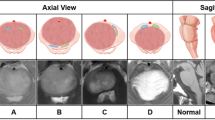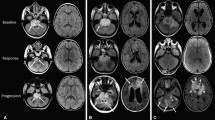Abstract
Diffuse intrinsic pontine glioma (DIPG) is the deadliest central nervous system tumor in children. The survival of affected children has remained poor despite treatment with radiation therapy (RT) with or without chemotherapy. We reviewed the medical records of all surviving patients with DIPG treated at our institution between October 1, 1992 and May 31, 2011. Blinded central radiologic review of the magnetic resonance imaging at diagnosis of all surviving patients and 15 controls with DIPG was performed. All surviving patients underwent neurocognitive assessment during follow-up. Five (2.6 %) of 191 patients treated during the study period were surviving at a median of 9.3 years from their diagnosis (range 5.3–13.2 years). Two patients were younger than 3 years, one lacked signs of pontine cranial nerve involvement, and three had longer duration of symptoms at diagnosis. One patient had a radiologically atypical tumor and one had a tumor originating in the medulla. All five patients received RT. Chemotherapy was variable among these patients. Neurocognitive assessments were obtained after a median interval of 7.1 years. Three of four patients who underwent a detailed evaluation showed cognitive function in the borderline or mental retardation range. Two patients experienced disease progression at 8.8 and 13 years after diagnosis. A minority of children with DIPG experienced long-term survival with currently available therapies. These patients remained at high risk for tumor progression even after long follow-ups. Four of our long-term survivors had clinical and radiologic characteristics at diagnosis associated with improved outcome.


Similar content being viewed by others
References
Hargrave D, Bartels U, Bouffet E (2006) Diffuse brainstem glioma in children: critical review of clinical trials. Lancet Oncol 7:241–248
Puget S, Philippe C, Bax DA et al (2012) Mesenchymal transition and PDGFRA amplification/mutation are key distinct oncogenic events in pediatric diffuse intrinsic pontine gliomas. PLoS One 7:e30313
Monje M, Mitra SS, Freret ME et al (2011) Hedgehog-responsive candidate cell of origin for diffuse intrinsic pontine glioma. Proc Natl Acad Sci USA 108:4453–4458
Broniscer A, Leite CC, Lanchote VL, Machado TM, Cristófani LM (2000) Radiation therapy and high-dose tamoxifen in the treatment of patients with diffuse brainstem gliomas: results of a Brazilian cooperative study. Brainstem Glioma Cooperative Group. J Clin Oncol 18:1246–1253
Greenberg ML, Fisher PG, Freeman C et al (2005) Etoposide, vincristine, and cyclosporin A with standard-dose radiation therapy in newly diagnosed diffuse intrinsic brainstem gliomas: a Pediatric Oncology Group phase I study. Pediatr Blood Cancer 45:644–648
Wagner S, Warmuth-Metz M, Emser A et al (2006) Treatment options in childhood pontine gliomas. J Neurooncol 79:281–287
Massimino M, Spreafico F, Biassoni V et al (2008) Diffuse pontine gliomas in children: changing strategies, changing results? a mono-institutional 20-year experience. J Neurooncol 87:355–361
Broniscer A, Baker JN, Tagen M et al (2010) Phase I study of vandetanib during and after radiotherapy in children with diffuse intrinsic pontine glioma. J Clin Oncol 28:4762–4768
Haas-Kogan DA, Banerjee A, Poussaint TY et al (2011) Phase II trial of tipifarnib and radiation in children with newly diagnosed diffuse intrinsic pontine gliomas. Neuro Oncol 13:298–306
Pollack IF, Stewart CF, Kocak M et al (2011) A phase II study of gefitinib and irradiation in children with newly diagnosed brainstem gliomas: a report from the pediatric brain tumor consortium. Neuro Oncol 13:290–297
Freeman CR, Bourgouin PM, Sanford RA, Cohen ME, Friedman HS, Kun LE (1996) Long term survivors of childhood brain stem gliomas treated with hyperfractionated radiotherapy. Clinical characteristics and treatment related toxicities. The Pediatric Oncology Group. Cancer 77:555–562
Allen J, Siffert J, Donahue B et al (1999) A phase I/II study of carboplatin combined with hyperfractionated radiotherapy for brainstem gliomas. Cancer 86:1064–1069
Hargrave D, Chuang N, Bouffet E (2008) Conventional MRI cannot predict survival in childhood diffuse intrinsic pontine glioma. J Neurooncol 86:313–319
Warren K, Bent R, Wolters PL et al (2012) A phase 2 study of pegylated interferon α-2b (PEG-Intron(®)) in children with diffuse intrinsic pontine glioma. Cancer 118:3607–3613
Barkovich AJ, Krischer J, Kun LE et al (1990/1991) Brain stem gliomas: a classification system based on magnetic resonance imaging. Pediatr Neurosurg 16:73–83
Fischbein NJ, Prados MD, Wara W, Russo C, Edwards MS, Barkovich AJ (1996) Radiologic classification of brain stem tumors: correlation of magnetic resonance imaging appearance with clinical outcome. Pediatr Neurosurg 24:9–23
Wechsler D (2003) Wechsler intelligence scale for children. The Psychological Corporation, San Antonio
Wechsler D (2008) Wechsler adult intelligence scale. The Psychological Corporation, San Antonio
Woodcock RW, McGrew KS, Mather N (2001) Woodcock–Johnson tests of achievement III. Riverside Publishing, Itasca
Wechsler D (2002) Wechsler individual achievement test. The Psychological Corporation, San Antonio
Bryant BR, Wiederholt L, Bryant DP (2004) Gray diagnostic reading tests. PRO-ED Inc., Austin
Gioia GA, Isquith PK, Guy SC, Kenworthy L (2000) Behavior rating inventory of executive function. Psychological Assessment Resources Inc., Odessa
Sanford RA, Freeman CR, Burger P, Cohen ME (1988) Prognostic criteria for experimental protocols in pediatric brainstem gliomas. Surg Neurol 30:276–280
Fisher PG, Breiter S, Carson BS et al (2000) A clinicopathologic reappraisal of brain stem tumor classification. Identification of pilocytic astrocytoma and fibrillary astrocytoma as distinct entities. Cancer 89:1569–1576
Pollack IF, Jakacki RI, Blaney SM et al (2007) Phase I trial of imatinib in children with newly diagnosed brainstem and recurrent malignant gliomas: a pediatric brain tumor consortium report. Neuro Oncol 9:145–160
Adams DM, Zhou T, Berg SL, Bernstein M, Neville K, Blaney SM (2008) Children’s Oncology Group. phase 1 trial of O6-benzylguanine and BCNU in children with CNS tumors: a Children’s Oncology Group study. Pediatr Blood Cancer 50:549–553
Kieran MW, Packer RJ, Onar A et al (2007) Phase I and pharmacokinetic study of the oral farnesyltransferase inhibitor lonafarnib administered twice daily to pediatric patients with advanced central nervous system tumors using a modified continuous reassessment method: a pediatric brain tumor consortium study. J Clin Oncol 25:3137–3143
Broniscer A, Iacono L, Chintagumpala M et al (2005) Role of temozolomide after radiotherapy for newly diagnosed diffuse brainstem glioma in children: results of a multiinstitutional study (SJHG-98). Cancer 103:133–139
Cohen KJ, Heideman RL, Zhou T et al (2011) Temozolomide in the treatment of children with newly diagnosed diffuse intrinsic pontine gliomas: a report from the Children’s Oncology Group. Neuro Oncol 13:410–416
Lezak MD, Howieson DB, Loring DW (2004) Neuropsychological assessment. Oxford University Press, New York
Garrard P, Bradshaw D, Jäger HR, Thompson AJ, Losseff N, Playford D (2002) Cognitive dysfunction after isolated brain stem insult. An underdiagnosed cause of long term morbidity. J Neurol Neurosurg Psychiatry 73:191–194
Hoffmann M, Watts A (1998) Cognitive dysfunction in isolated brainstem stroke: a neuropsychological and SPECT study. J Stroke Cerebrovasc Dis 7:24–31
Hoffmann M, Schmitt F (2004) Cognitive impairment in isolated subtentorial stroke. Acta Neurol Scand 109:14–24
Wu G, Broniscer A, McEachron TA et al (2012) Somatic histone H3 alterations in pediatric diffuse intrinsic pontine gliomas and non-brainstem glioblastomas. Nat Genet 44:251–253
Khuong-Quang DA, Buczkowicz P, Rakopoulos P et al (2012) K27M mutation in histone H3.3 defines clinically and biologically distinct subgroups of pediatric diffuse intrinsic pontine gliomas. Acta Neuropathol 124:439–447
Acknowledgments
This work was supported by the US National Institutes of Health Cancer Center Support (CORE) Grant P30 CA21765 and by the American Lebanese Syrian Associated Charities (ALSAC). All procedures described in this manuscript were performed in compliance with clinical research regulations in the United States.
Conflict of interest
The authors declare that they have no conflict of interest.
Author information
Authors and Affiliations
Corresponding author
Rights and permissions
About this article
Cite this article
Jackson, S., Patay, Z., Howarth, R. et al. Clinico-radiologic characteristics of long-term survivors of diffuse intrinsic pontine glioma. J Neurooncol 114, 339–344 (2013). https://doi.org/10.1007/s11060-013-1189-0
Received:
Accepted:
Published:
Issue Date:
DOI: https://doi.org/10.1007/s11060-013-1189-0




